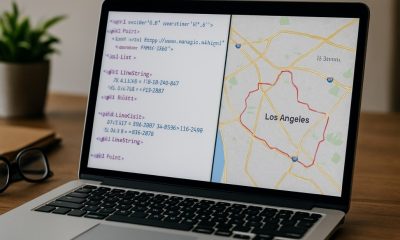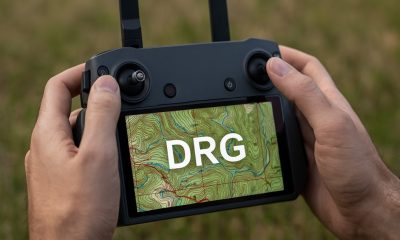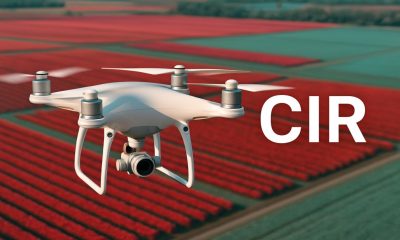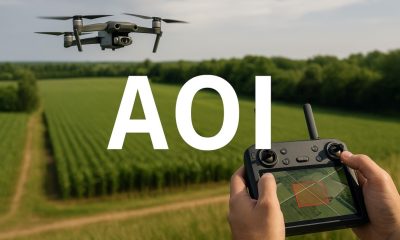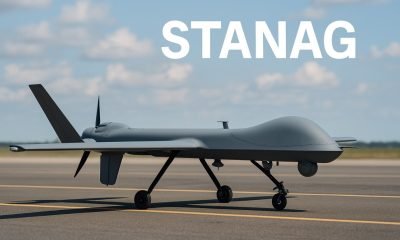- Acronym Guide
- AAM
- ABS
- AC
- ACAS
- ADS-B
- AFAC
- AGL
- AI
- AIM
- ALS
- AM
- AMA
- ANSP
- AOI
- APPI
- AUV
- AUVSI
- ARPAS-UK
- ASTM
- ATC
- BVLOS
- CAA
- CAAC
- CAB
- CASA
- CATT
- CBO
- CBR
- CBRN
- CDMA
- CDR
- CFR
- CIR
- COA
- COMINT
- CORS
- COTP
- COTR
- CPTED
- CV
- C2
- DAA
- DEM
- DFI
- DFS
- DGCA
- DHS
- DOD
- DPA
- DPEs
- DRG
- DRO
- DSM
- DSMX
- DSP
- DSSS
- DTM
- EASA
- EFT
- EO
- EOD
- EO/IR
- ELINT
- EMI
- ESC
- EVLOS
- eVTOLs
- FAA
- FCC
- FCS
- FHSS
- FICCI
- FLIR
- FOB
- FOV
- FPS
- FPV
- GBDAA
- GCP
- GCS
- GDPR
- GML
- GNSS
- GPS
- GSD
- GVC
- HDR
- HOGE
- IACRA
- ICAO
- ICS
- IMU
- INS
- IR
- ISA
- ISR
- ITU
- JARUS
- LAAMS
- LAANC
- LAATM
- LAI
- LBA
- LIDAR
- LOS
- LSALT
- MAC
- MAVLink
- MLIT
- MMS
- MSL
- MTOM
- NDAA
- NCSL
- NFZ
- NIST
- NMEA
- NOTAM
- NPA
- NPRM
- NTIA
- OBIA
- OEM
- OFDM
- OOP
- PASM
- PAV
- PCV
- PdM
- PEC
- PIC
- PID
- PIPL
- PLD
- PM
- PN
- PPK
- PPS
- PSM
- PWM
- UAM
- UAOP
- UAS
- UASTM
- UAV
- UCAVs
- UHD
- UHF
- USV
- UTM
- RAIM
- RCC
- RCS
- RFI
- ReOC
- RePL
- RMS
- ROI
- RPAS
- RPC
- RTH
- RTK
- SaR
- SAR
- SARP
- SBAS
- S.Bus
- SBIR
- SEDENA
- SfM
- SFOC
- SIGINT
- SLAM
- SMS
- SORA
- STANAG
- STTR
- sUAS
- TCAS
- TCCA
- TFR
- TIN
- TOF
- TP
- TPS
- TSA
- VHF
- VLOS
- VTOL
Drone Acronyms
What is FOV (Field of View) & How Does it Work?
By
Jacob StonerTable Of Contents

Definition
FOV (Field of View) refers to the extent of the observable area that a camera or lens can capture at a given moment. Measured in degrees, Field of View determines how much of the scene in front of the camera is included in the frame. A wider Field of View captures more of the scene but can introduce distortion, while a narrower FOV provides a zoomed-in view with less context.
Usage
In drones, FOV is a critical parameter for cameras and sensors used in applications like aerial photography, videography, mapping, and inspections. The FOV affects the composition of images, the amount of detail captured, and the suitability of the camera for specific tasks, such as wide-area surveillance or close-up inspections.
Relevance to the Industry
FOV directly impacts how drones capture and present data. Wide Field of View cameras are ideal for surveying large areas or creating immersive panoramic views, while narrow Field of View cameras are better suited for tasks requiring detailed observation, such as infrastructure inspections or wildlife monitoring.
How Does Field of View (FOV) Work?
Core Principles of FOV:
- Understanding FOV:
- Definition in Optics: Field of View is the angular measurement, typically in degrees, of the observable area captured by a camera or lens. It determines how much of the scene in front of the camera is included in the frame.
- Impact of Lens Design: The Field of View is largely determined by the focal length of the lens and the size of the camera sensor. Wide-angle lenses produce a larger Field of View, capturing more of the scene, while telephoto lenses create a narrower Field of View, focusing on smaller portions with greater detail.
- Wide vs. Narrow FOV:
- Wide FOV: A wider Field of View, such as 120°, captures more area and is ideal for panoramic shots, landscapes, or surveillance. However, it may introduce distortion, especially at the edges of the frame.
- Narrow FOV: A narrow Field of View, such as 30°, focuses on a smaller portion of the scene, providing greater detail and clarity for distant or specific subjects, such as infrastructure inspections.
FOV in Drone Cameras:
- Relationship Between FOV and Altitude:
- Increased Coverage at Higher Altitudes: As a drone ascends, the Field of View expands, allowing the camera to capture a larger area of the ground. This is particularly useful for aerial surveys or mapping large regions.
- Detailed Views at Lower Altitudes: At lower altitudes, the Field of View decreases, making it easier to capture detailed, close-up images of specific objects or structures.
- Adjustable FOV Settings:
- Digital Adjustment: Some drones allow operators to digitally adjust the Field of View, switching between wide and narrow views depending on the mission’s requirements. This is achieved through cropping or changing the effective resolution.
- Interchangeable Lenses: High-end drones may support interchangeable lenses, enabling users to select a lens with the desired Field of View for specific tasks.
Applications of FOV in Drone Operations:
- Photography and Videography:
- Wide FOV for Scenic Shots: Wide Field of View lenses are ideal for capturing stunning aerial landscapes, cityscapes, and dynamic event coverage.
- Narrow FOV for Focused Shots: Narrow Field of View settings are preferred for detailed shots of specific subjects, such as architectural details or wildlife.
- Mapping and Surveying:
- Wide FOV for Efficiency: A wide Field of View allows drones to cover larger areas in fewer flights, making it ideal for agricultural surveys, topographic mapping, or environmental monitoring.
- Optimizing Overlap: By understanding the Field of View, operators can optimize flight paths to ensure sufficient overlap between images for photogrammetry and 3D modeling.
- Inspection and Monitoring:
- Detailed Inspections: Narrow Field of View cameras are used for close-up inspections of infrastructure like bridges, power lines, and pipelines, where capturing fine details is crucial.
- Surveillance and Security: A wide Field of View enables better situational awareness, covering large areas for monitoring and reconnaissance missions.
Technical Considerations:
- Sensor and Lens Relationship:
- Sensor Size: Larger camera sensors support wider Field of Views without introducing significant distortion, providing better image quality.
- Lens Focal Length: Shorter focal lengths produce wider Field of Views, while longer focal lengths result in narrower, more focused views.
- Distortion and Quality Trade-Offs:
- Edge Distortion in Wide FOVs: Wide-angle lenses may introduce barrel distortion, where straight lines appear curved at the edges. Advanced drones use software to correct this distortion.
- Resolution Impact: Wide Field of Views spread pixels across a larger area, potentially reducing detail in distant objects. Narrow FOVs concentrate pixels, enhancing clarity for targeted views.
Optimizing FOV for Drone Missions:
- Mission-Specific FOV Selection:
- Wide FOV Use Cases: Choose wide Field of View for broad surveys, event coverage, or capturing scenic vistas where context is more important than fine detail.
- Narrow FOV Use Cases: Opt for narrow Field of View for precision tasks like inspections, wildlife tracking, or cinematic close-ups.
- Post-Processing Considerations:
- Cropping and Zooming: Operators can digitally crop or zoom wide Field of View footage during post-production to focus on specific areas, though this may reduce resolution.
- Stitching Panoramas: Wide Field of View images can be stitched together to create panoramic views or orthomosaic maps for surveying and environmental studies.
By adjusting and optimizing the Field of View (FOV) based on lens characteristics, altitude, and mission requirements, drone operators can achieve tailored results for diverse applications, from expansive aerial surveys to detailed inspections.
Example in Use
“The drone’s camera had a 90° Field of View, enabling it to capture wide-angle shots of the landscape while minimizing distortion.”
Frequently Asked Questions about FOV (Field of View)
1. What determines the FOV of a drone camera?
Answer: The Field of View is influenced by:
- Lens Design: Wide-angle lenses provide a larger Field of View, while telephoto lenses reduce it.
- Sensor Size: Larger sensors can support wider Field of Views without compromising image quality.
- Camera Settings: Adjustable Field of Views may be available on some drones, allowing operators to switch between wide and narrow views.
2. When should I use a wide FOV for drone operations?
Answer: Use a wide Field of View for:
- Panoramic Shots: Capturing expansive landscapes or urban areas.
- Surveys: Covering large areas for mapping or environmental monitoring.
- Dynamic Scenes: Recording events or subjects with high movement across the frame.
3. How does FOV impact image quality?
Answer:
- Wide Field of View: Can introduce edge distortion and reduce detail in distant objects.
- Narrow Field of View: Provides higher clarity and detail for focused subjects but limits the visible area.
For examples of these acronyms visit our Industries page.
As the CEO of Flyeye.io, Jacob Stoner spearheads the company's operations with his extensive expertise in the drone industry. He is a licensed commercial drone operator in Canada, where he frequently conducts drone inspections. Jacob is a highly respected figure within his local drone community, where he indulges his passion for videography during his leisure time. Above all, Jacob's keen interest lies in the potential societal impact of drone technology advancements.


